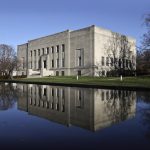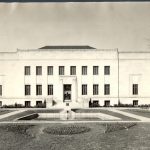Kathy Johnson Bowles brought with her decades of experience in museums and as an artist in her own right when she took charge of the Everhart Museum.
The North Carolina native joined the Scranton museum as executive director on March 15 and said she has had “a wonderful introduction” to the area so far. She took over from Aurore Giguet, who resigned in June to move to the Pacific Northwest, and Bowles wants Northeast Pennsylvania residents to know how happy she feels to be part of her new community.
“I’m just fascinated by the history, and I feel a sense of connection,” said Bowles, who now lives in downtown Scranton. “My family immigrated from Ireland and worked in the mills in Massachusetts, and my great-grandfather was a trolley conductor. So when I read about Scranton and … how people lived and what they did, I look back on the old photographs of my own family and think about their lives, and it helps me have a connection to place here.”
Bowles began working in museums at 18, and her internship at the North Carolina Museum of Life and Science “sparked something” that set off her career.
“It was the sense that there was a lot of fun in learning and knowing, and it was always something new to experience,” she recalled. “And I just went from there.”
She loves learning about objects and sharing their stories and their importance with others.
“A museum is a kind of place where everyone is welcome, and it doesn’t matter where you come from or who you are; it’s a very welcoming space for a community, and so that’s what really hooked me,” Bowles said.
Bowles earned a bachelor’s degree in painting from Boston University and a master’s degree in fine arts in painting and photography from Ohio University. She continues to create her own work, focusing on fiber art, and regularly exhibits her pieces. Art attracted her in part because of its storytelling qualities and the symbolism it includes, she said.
“That can be life-changing,” Bowles said. “It can be revelatory, it can be empathetic and compassionate, it can change the way people think and behave.”
And having an artistic background can prove to be valuable in a museum leader.
“I think I understand … the process of making and creating in a way that’s perhaps different than perhaps a historian, and that gives me perhaps some particular ability to impart how an artist works and how they think and why they might make certain choices,” she said.
Bowles spent most of her career working in museums and galleries, including stints as gallery director at St. Mary’s College in Notre Dame and as museum director for the Longwood Center for the Visual Arts at Longwood University in Virginia, which involved getting national accreditation, overseeing an eclectic collection and working on fundraising. She served as CEO of Gordian Knot Consulting; sat on numerous state, regional and national boards; and was a fellow with the American Council on Education, the Harvard Management Institute and the National Endowment for the Arts.
“(Bowles) received more than a dozen international, national and regional awards for excellence in programs and publications,” Don Frederickson, chairman of the museum’s board of trustees, said in a statement. “Her experience is extensive, and the board of trustees and I have much confidence in her ability to provide the guidance and leadership needed as we look to the future.”
She decided to pursue the Everhart job because she loved not only the history of founder Dr. Isaiah Fawkes Everhart and his vision but also the museum’s interdisciplinary nature and how the subjects connect.
“To combine natural history, science and art at the same time is both exciting and challenging as a concept. … There’s a lot of richness,” she said. “Things don’t exist in a vacuum, and how does science impact design and art?
“I think about even some of our companies in Scranton and NEPA. I think about Gentex, for example. They’ve been around for a long time, but their designs have been really important to saving people’s lives. I think a lot about that, and I think about the rich history. … I got really excited for the possibility of learning and connecting with such a historically important region and city.”
Moving to Scranton also brought Bowles closer to her daughter, Cade, who lives in Philadelphia and seems to have inherited her mother’s creative nature.
“She’s quite a writer,” Bowles said. “She’s more talented than I could ever be. She’s fantastic, and we’re a good team. She often will critique my work, and so we share a lot.”
While she doesn’t have a favorite piece at the Everhart — “That’s like choosing your favorite child,” she said with a laugh — she has found much to love, from the natural history collection’s legendary bird room to pieces by local artists such as John Willard Raught to the folk art collection, a field that particularly interests her.
Bowles, who took over during the pandemic not long after the Everhart reopened to visitors, praised its staff for being “incredibly creative” in offering online programs during its COVID-19 closure. The pandemic made for a stressful time during which it was tough to imagine how to keep operating, she said, but it also served as a kind of pit stop when staff could “think about, well, what do we want to do in the future, and how can we engage more and more people?’”
“Some people might find it as a challenge to be in this spot, but I find it very exciting to imagine the future with this team and this board and this community,” Bowles said.
People find healing and hope through museums and art, too, which she believes can help them imagine a different future.
“I’m really inspired by especially when there’s dark times and how objects can remind us of when we were strong before and we made it through, how objects can help us think about solving problems in a different way (and) how it can be a revelation for a small child to think about what they would do with their life and how they might contribute,” she said.
Bowles has jumped right into her new job, working with her team to assess the museum to create a data-focused report for the board of directors. They will spend the summer doing strategic planning to lay out a vision for the next five years before meeting with community stakeholders this fall.
When it comes to making her mark on the Everhart, Bowles wants it foremost to become “one of the most significant regional museums” in the nation. She’d like to renovate its exhibit spaces — but not necessarily change them “in terms of what’s really important to the community,” she added — and also make it accessible to more people.
“I think that that is our greatest hope, is that no matter who you are, where you are in your life, that the museum would ultimately be free,” Bowles said. “And so in terms of fundraising, I really want us to be able to get others to help us and partner (with us) so that we can offer more to the public without any of them worrying about how much it costs. That’s really an important part of service.”

Caitlin Heaney West is the content editor for Access NEPA and oversees the Early Access blog in addition to working as a copy editor and staff writer for The Times-Tribune. An award-winning journalist, she is a summa cum laude graduate of Shippensburg University and also earned a master’s degree from Marywood University. Caitlin joined the Times-Shamrock family in 2009 and lives in Scranton. Contact: cwest@timesshamrock.com; 570-348-9100 x5107; or @cheaneywest



